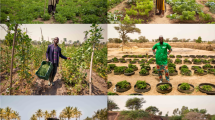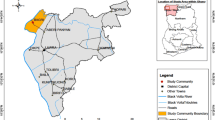Abstract
This paper explores the lessons learned by leaders in agricultural adaptation planning in order to assist other jurisdictions to develop adaptation strategies. It seeks to identify effective institutional, participatory and collaborative processes involved in designing agricultural adaptation strategies at the national and sub-national levels in Germany, Finland, the United Kingdom, the United States and Canada. Its methodology is based on review of agricultural adaptation policy documents, research initiatives, stakeholder engagement processes, and cross-sectoral collaborations as well as interviews with key informants such as leaders and actors in adaptation planning. The gathered data show that early adapters have an improved regional and national understanding of climatic impacts, and of the risks to agriculture before the initiation of the planning process. The results indicate that the interplay between bottom-up and top-down initiatives has been crucial in the development of adaptation strategies. The former has provided rich and robust participation in designing, implementing and monitoring adaptations, while the latter was important for prioritizing and legitimizing the development of strategy. It also provided access to high-level decision makers and funding. The results of the study suggest that fostering cross-sectoral collaborations—especially by focusing on broader questions such as the role of agriculture in society—has become an important part of adaptation planning. Finally, our results also stress that adaptation planning in agriculture could be enhanced by skills development and mutual learning across stakeholder groups, research and policy-makers, and through the ongoing interactive development of institutional capabilities.

Similar content being viewed by others
References
Academy of Finland (2009) Research programme on climate change., Accessed 5/01/2010 at: http://www.aka.fi/en-gb/A/Science-in-society/Research-programmes/Research-programmes-being-prepared/Climate_change-ficca/
Adger WN, Brown K, Nelson DR et al (2011) Resilience implications of policy responses to climate change. Wiley Interdiscip Rev: Clim Chang 2(5):757–767
Andreadis K, Konstantinos M, Clark EA et al (2005) Twentieth-century drought in the conterminous United States. J Hydrometeor 6:985–1001
Atkinson R, Flint J (2001) Accessing hidden and hard-to-reach populations: snowball research strategies. Social research UPDATE. Department of Sociology, University of Surrey, Guildford, p 4, http://sru.soc.surrey.ac.uk/SRU33.pdf
Belliveau S, Smit B, Bradshaw B (2006) Multiple exposures and dynamic vulnerability: evidence from the grape industry in the Okanagan Valley, Canada. Glob Environ Chang 16(4):364–378
Biesbroek GR, Swart RJ, Carter TR et al (2011) Europe adapts to climate change: comparing national adaptation strategies. Glob Environ Chang 20:440–450
Brown K (2011) Sustainable adaptation: an oxymoron? Clim Dev 3:21–31
California Natural Resources Agency (2009) California climate adaptation strategy: a report to the governor of the state of California in response to executive order S-13-2008., Accessed 12/03/2010 at: http://www.energy.ca.gov/2009publications/CNRA-1000-2009-027/CNRA-1000-2009-027-F.PDF
Carter TR (2007) Assessing the adaptive capacity of the Finnish environment and society under a changing climate: FINADAPT (No. 1/2007). The Finnish Environment, Helsinki
Climate Change Act (2008) UK Public general acts, pp. 108. http://www.legislation.gov.uk/ukpga/2008/27/pdfs/ukpga_20080027_en.pdf
Climate Change Scotland Act (2009) Accessed on 12/07/2012 at: http://www.legislation.gov.uk/asp/2009/12/contents
ClimateXChange (Scottish Centre of Expertise on Climate Change) (2011) Scotland’s centre of expertise connecting climate change research and policy., Accessed on 12/07/2012 at: http://www.climatexchange.org.uk/
Coffey A, Atkinson P (1996) Making sense of qualitative data. Sage, Thousand Oaks
Crawford E, MacNair E (2012) British Columbia agriculture climate change risk and opportunity assessment. BC Agriculture and Food Climate Action Initiative, Abbotsford
DEFRA (2009) Adapting to climate change: UK climate projections. Defra, London, Accessed 07/01/2010 at: http://www.defra.gov.uk/environment/climate/documents/uk-climate-projections.pdf
DEFRA (2010) Defra’s climate change plan 2010. Defra, London, Accessed 10/04/2010 at: http://www.defra.gov.uk/environment/climate/documents/climate-change-plan-2010.pdf
Easterling WE, Aggarwal PK, Batima P et al (2007) Food, fibre and forest products. In: Parry ML, Canziani OE, Palutikof JP et al (eds) Climate change 2007: impacts, adaptation and vulnerability. Contribution of working group II to the fourth assessment report of the intergovernmental panel on climate change. Cambridge University Press, Cambridge, pp 273–313
Eriksen S, Aldunce P, Bahimipati CS et al (2011) When not every response to climate change is a good one: identifying principles for sustainable adaptation. Clim Dev 3:7–20
European Commission (2009a) Adapting to climate change: towards a European framework for action. White paper, COM(2009) 147 final. Brussels. http://eurlex.europa.eu/LexUriServ/LexUriServ.do?uri=CELEX:52009DC0147:en:NOT
European Commission (2009b) Adapting to climate change: the challenge for European agriculture and rural areas. Commission staff working document, SEC(2009) 417. Brussels. http://eurlex.europa.eu/LexUriServ/LexUriServ.do?uri=SEC:2009:0417:FIN:EN:PDF
Federal Government of Germany (2008) German strategy for adaptation to climate change., Adopted by the German federal cabinet on 17th December 2008. Accessed 7/1/10 at: http://www.bmu.de/files/english/pdf/application/pdf/das_gesamt_en_bf.pdf
Gagnon-Lebrun F, Agrawala S (2007) Implementing adaptation in developed countries: an analysis of progress and trends. Clim Pol 7:1–17
Hallegatte S (2009) Strategies to adapt to an uncertain climate change. Glob Environ Chang 19:240–247
Hannaford J, Lloyd-Hughes B, Keef C et al (2010) Examining the large-scale spatial coherence of European drought using regional indicators of precipitation and streamflow deficit. Hydrol Process 25(7):1146–1162
Howden MS, Soussana JF, Tubiello FN et al (2007) Adapting agriculture to climate change. Proc Natl Acad Sci 104:19691–19696
Huitema D, Jordan A, Massey E, Rayner T, Asselt H, Haug C et al (2011) The evaluation of climate policy: theory and emerging practice in Europe. Pol Sci 44:179–198
IPCC (2007) Summary for policymakers. In: Parry M et al (eds) Climate change 2007: impacts, adaptation and vulnerability. Contribution of working group II to the fourth assessment report of the intergovernmental panel on climate change. Cambridge University Press, Cambridge
IPCC (2012) In: Field CB, Barros V, Stocker TF et al (eds) Managing the risks of extreme events and disasters to advance climate change adaptation. A special report of working groups I and II of the intergovernmental panel on climate change. Cambridge University Press, Cambridge and New York, p 582
Knox JW, Hurford A, Hargreaves L et al (2012) Climate change risk assessment for the agriculture sector. DEFRA, United Kingdom
Lemmen DS, Warren FJ, Lacroix J et al (eds) (2008) From impacts to adaptation: Canada in a changing climate 2007. Government of Canada, Ottawa, p 448
Macgregor NA, Cowan C (2010) Government action to promote sustainable adaptation by the agriculture and land management sector in England. In: Ford JD, Berrang Ford L (eds) Climate change adaptation in developed nations. Springer, Berlin Heidelberg New York
Marttila V, Granholm H, Laanikari J et al (eds) (2005) Finland’s national strategy for adaptation to climate change. Ministry of Agriculture and Forestry, Helsinki
McGray H, Hammill A, Bradley R (2007) Weathering the storm options for framing adaptation and development. World Resources Institute, Washington DC
Moser SC (2005) Impacts assessments and policy responses to sea-level rise in three U.S. states: an exploration of human dimension uncertainties. Glob Environ Chang 15:353–369
Moser SC, Luers LA (2007) Managing climate risks in California: the need to engage resource managers for successful adaptation to change. Clim Chang 87(1):309–322
Naess LO, Bang G, Eriksen S et al (2005) Institutional adaptation to climate change: flood responses at the municipal level in Norway. Glob Environ Chang 15(2):125–138
Natural Resources Canada (2010) Regional adaptation collaboratives., http://adaptation.nrcan.gc.ca/collab/index_e.php. Accessed 17 August 2010
Nelson R, Kokic P, Crimp S et al (2010) The vulnerability of Australian rural communities to climate variability and change: part II—integrating impacts with adaptive capacity. Environ Sci Pol 13:18–27
OECD (2009) Integrating climate change adaptation into development cooperation - policy guidance. OECD, Paris, p. 197.
Reidsma P, Ewert F, Lansink AO et al (2010) Adaptation to climate change and climate variability in European agriculture: the importance of farm level responses. Eur J Agron 32:91–102
Rosenzweig C, Tubiello FN (2007) Adaptation and m mitigation strategies in agriculture: an analyses of potential synergies. Mitig Adapt Strateg Glob Chang 12:855–873
Sauchyn D, Kulshreshtha S (2008) Prairies. In: Lemmen, Warren, Lacroix et al (eds) From impacts to adaptation: Canada in a changing climate 2007. Government of Canada, Ottawa, pp 275–328
Smit B, Wandel J (2006) Adaptation, adaptive capacity and vulnerability. Glob Environ Chang 16(3):282–292
State of California (2010) Climate action team reports., State of California website: California Climate Change Portal. Accessed 18/03/10 at http://www.climatechange.ca.gov/publications/cat/index.html
Steurer R, Martinuzzi A (2005) Towards a new pattern of strategy formulation in the public sector: first experiences with national strategies for sustainable development in Europe. Environ Plann C Govern Pol 23:455–472
Swart R, Biesbroek R, Binnerup S et al (2009) Europe adapts to climate change: comparing national adaptation strategies. PEER report No 1. Partnership for European Environmental Research, Helsinki
Tang Z, Wang J, Koperski T (2010) Measuring local climate change response capacity and bridging gaps between local action plans and land use plans. Intern J Clim Chang Strateg Manag 3(1):74–100
The Scottish Government (2011) Sector action plans., Accessed 17/07/2012 at: http://www.scotland.gov.uk/Topics/Environment/climatechange/scotlands-action/adaptation/AdaptationFramework/SAP
The UK Climate Impacts Programme (UKCIP) (2011) Making progress: UKCIP and adaptation in the UK. Oxford, pp 99
Urwin K, Jordan A (2008) Does public policy support or undermine climate change adaptation? Exploring policy interplay across different scales of governance. Glob Environ Chang 18:180–191
van Aalst MK, Cannon T, Burton I (2008) Community level adaptation to climate change: the potential role of participatory community risk assessment. Glob Environ Chang 18(1):165–179
Walker I, Sydneysmith R (2008) British Columbia. In: Lemmen, Warren, Lacroix et al (eds) From impacts to adaptation: Canada in a changing climate 2007. Government of Canada, Ottawa, pp 329–386
Washington State Department of Ecology (2008) Leading the way: preparing for the impacts of climate change in Washington., Accessed 12/03/2010 at: http://www.ecy.wa.gov/climatechange/ipa_resources.htm
Washington State Department of Ecology (2010) Statement of work: tag #4 natural resources (Working lands and waters)., Accessed 12/03/2010 at: http://www.ecy.wa.gov/climatechange/2010TAGdocs/R0317_sow.pdf
Wisconsin Initiative on Climate Change Impacts (WICCI) (2011) Wisconsin’s changing climate: impacts and adaptation. 2011. Wisconsin initiative on climate change impacts. Nelson Institute for Environmental Studies, University of Wisconsin-Madison and the Wisconsin Department of Natural Resources, Madison
Zebisch MT, Grothmann T, Schröter D et al. (2005) Climate change in Germany: vulnerability and adaptation of climate sensitive sectors. Federal environment ministry (Umweltbundesamt), Research Report 201 41 253. Dessau
Acknowledgements
We would like to thank all of the interviewees participating in this study. We are also grateful for support from Horizons (formerly Policy Research Initiative), the Institute for Forecasting at the Slovak Academy of Sciences project’s VEGA 2/0213/09 (1/2009–12/2012), from the Adaptation workstream of the Scottish Centre of Expertise on Climate Change, and for support provided by the Environment and Rural Affairs Department of the Scottish Government.
Author information
Authors and Affiliations
Corresponding author
Rights and permissions
About this article
Cite this article
Bizikova, L., Crawford, E., Nijnik, M. et al. Climate change adaptation planning in agriculture: processes, experiences and lessons learned from early adapters. Mitig Adapt Strateg Glob Change 19, 411–430 (2014). https://doi.org/10.1007/s11027-012-9440-0
Received:
Accepted:
Published:
Issue Date:
DOI: https://doi.org/10.1007/s11027-012-9440-0




